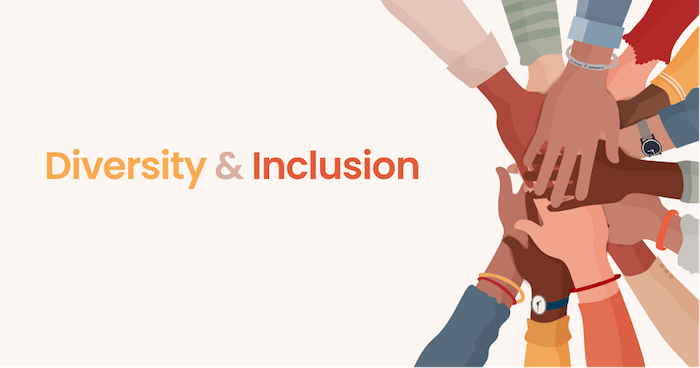Simple Changes You Can Make for a More Inclusive Workplace

It's not enough to hire individuals with diverse backgrounds, cultures, and lifestyles to lead an inclusive company. That is a good start, but inclusion needs more effort from team leaders.
As Alexis Herman (first African American to become the Secretary of Labor, serving during President Bill Clinton's second term) said, “Inclusion and fairness in the workplace is not simply the right thing to do; it's the smart thing to do.”
So, why not make "Creating an inclusive workplace culture" one of your business’ primary goals this year?
In this post, we'll highlight how you can achieve that objective, so keep reading to learn more and enhance your workplace and leadership skills even more!
Before we get into how to create an inclusive workplace, it's crucial to understand what it means.
Difference Between Diversity and Inclusion
Often, inclusion is confused with diversity, and the two terms are misused interchangeably. In order to form a good working environment, diversity and inclusion are both required.
However, they differ in that whereas diversity refers to differences and similarities among people, inclusion is concerned with embracing and celebrating those distinctions.
An office that includes employees from several countries, sexual orientations, religions, other backgrounds, and persons with disabilities is called a diverse workplace.
An inclusive workplace would be an organization that recognizes and values all of these differences while ensuring that everyone feels welcomed and appreciated for who they are.
Experts have argued and shown diversity and inclusion are key ingredients for success!
Why Inclusion Matters in the Workplace

You will not find a simple answer to this question than this… As human beings, we should always help and encourage one another.
Open-mindedness may only result in forward-thinking connections whether we're talking about employees, individuals in critical roles, your business partners, and so on.
Employees who are receptive to new ideas, methods, concepts, viewpoints, and possibilities will flourish. But that’s not all…
Reaserch show inclusion and diversity are also beneficial for business because:
- Diverse teams perform 87% better at decision-making.
- Diverse companies had 19% higher innovation earnings than less diversified ones.
- Ethnic diversity increases the probability of exceeding average financial returns by 35%.
- 43% of firms with multiethnic boards achieved better results than those without.
Top Tips (and Strategies) for a More Inclusive Workplace

Here’s how you can transform your work environment into an inclusive workplace:
1. Maintain a connection with your employees
If you want your workplace to be welcoming, start by being a role model. Consider your employees’ connections with you. Do you believe that how you conduct yourself with your team members allows them to be more open and honest with you?
It's a fact that the only way to create an inclusive workplace is if everyone feels welcome to talk with you and be judged fairly. So, make a concerted effort to connect with your staff on a personal and genuine level. This is the first step on your path to inclusion.
Don't make any unfair judgments about people's lifestyles; instead, allow them to speak up freely. Because this is a case of social power, be prepared for some uncomfortable conversations and discussions. Not everyone will embrace an inclusive approach.
Plan what to do if a client, partner, employee, or manager judges or excludes someone. Prepare to defend your inclusivity principles well when someone attempts to refute them.
2. Keep an open mind always
It's just as important to be open-minded as it is to communicate openly with others.
So, to make people feel welcome, put your preconceived notions and biases aside. We all have them, but they aren't helpful for making teams feel valued and at ease.
Instead, make it a point to learn the truth about other people and their cultures on your journey for greater workplace inclusivity. Even if you've never worked in an inclusive environment before, time and experience will teach you what is appropriate and what isn't.
You’ll be more successful in the workplace if you check how your attitude impacts others, are open to hearing other points of view, and are willing to modify your own behavior as necessary.
3. Celebrate and support your employees
You probably already know that connecting with your employees with open communication channels is the best approach. But, what's the next step? Well, it's celebrating them as well!
It's great to be heard, but being recognized and celebrated is often far better. Invite your team to share their diverse cultures and customs with the rest of the team. This is a fantastic thing to do since everyone will learn something new about their workmates.
Another way you can recognize, accommodate, and show appreciation for the various cultures in the workplace is to set aside a prayer/meditation room in the office. People shouldn't be forced to abandon their religion or spirituality in the workplace.
Setting a prayer, meditation, or reflection space in the workplace allows employees to securely and privately pray or reflect when appropriate, and that makes them know that their diverse cultures and beliefs are not only recognized, but also respected in the workplace.
Workers shouldn’t have to choose between their beliefs and their job.
4. Create a shared calendar
Encourage your staff to mark in the company calendar important/cultural holidays, celebrations, and events that are meaningful and significant to them each year, even if others may not know about the holidays or special days.
This way, on special days such as New Year, Diwali, Kwanzaa, and Id, you’ll demonstrate appreciation for the various cultures by holding little gatherings at the workplace.
5. Teach/train your staff about cultural tolerance
Investing in this form of training may not be the first thing you think about when setting up your company', but it is very important and beneficial for everyone.
You may start training with something as simple as a monthly workshop on issues like gender equality, workplace microaggressions, sexual harassment, mental health, and managing personal biases and preconceptions.
6. Involve employees in how your meetings are conducted
Strive to ensure everyone feels like they can contribute to whatever is being talked about at meetings. That is another powerful way to foster inclusivity in the workplace.
When planning meetings, many executives and managers create broad guidelines without consulting the attendees. However, involving the people who’ll be attending and taking into account their specific inclinations and cultural nuances may be a better approach
For example, you can do that and involve everyone in meetings by creating a timetable for meetings ahead of time and sending it to all participants. This is good for everyone since it provides more time to consider suggestions and ideas.
It's also a good idea for introverted or socially anxious workers. Giving them time to prepare themselves will boost their confidence. That in turn will making it easier for them to speak up in meetings and express their opinion with everyone.
Plus, if you have teammates who don't speak English as their first language, this technique will confirm that they grasp what's being said.
7. Check your communication style
You might have heard about mansplaining: it's when a man explains something to a woman in a conceited, condescending or patronizing manner, assuming she doesn't already know it.
That is an example of poor communication that does not promote inclusion but instead makes people feel looked down upon, demeaned and or excluded.
The same communication mistake can happen when talking to people from other religions, races, regions, and more. To avoid it, be careful to address everyone on the same level.
By checking your communication style, you will make everyone more comfortable and they can then share their thoughts and let you know when they need more clarification.
8. Make Resource groups
It may be that some of your employees are not unclear on what their strengths are and the unique distinctions they have compared to the rest of the team. Initiating employee resource groups is a fantastic approach to address this.
Determine your team members strengths and requirements using an anonymous questionnaire. Based on the responses, establish groups that focus on subjects that will help each of your team members improve their self-awareness and self-confidence at work.
9. Respond to complains swiftly to make everyone feel safe
As previously noted, not everyone will be a supporter of diversity and inclusion. This may put minorities in danger and make them targets of harassment and threats.
You must do something about it as soon as an issue arises or a complaint is made to ensure the workplace is a safe place for everyone.
If you discover your workplace isn't a safe environment for everyone—including minorities, work fast to take necessary actions to correct that and make everyone feel safe again.
If someone approaches you with an issue, be fair and contact everyone involved so you reach an appropriate solution that is equitable and to prevent a similar issue arising again.
Nip every case of unfairness in the bud with speed.
10. Keep talking about Inclusivity in the workplace
Finally, be vocal about the need for inclusion in your workplace. And do not tire or relent from talking about the need and value of inclusivity in the workplace.
Some ways you can do that includee:
- Celebrating diversity in a bold way on social media, company website, etc.
- Adding inclusion as a center/core value of your company marketing and branding
- Ensuring inclusion is a fundamental value in your talent onboarding processes.
Employee productivity, satisfaction, and retention will on the high when you manage to create an inclusive workplace. Good luck!



















